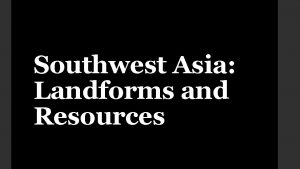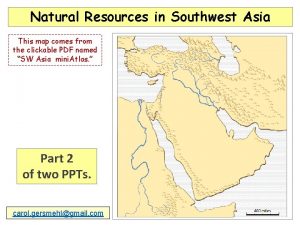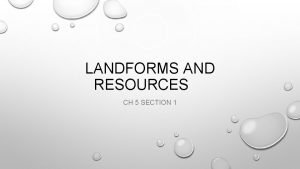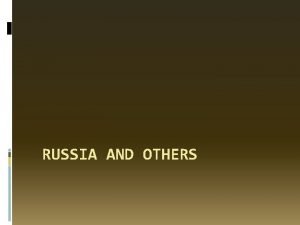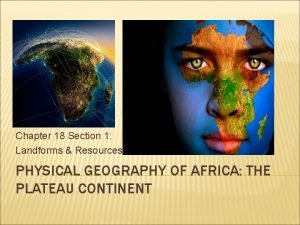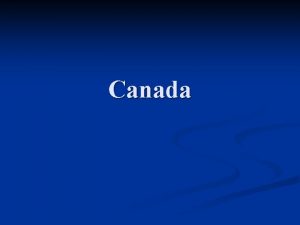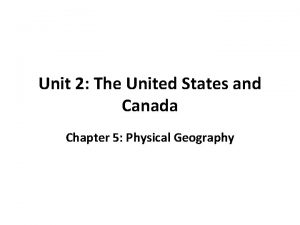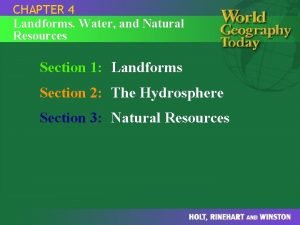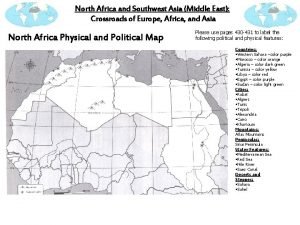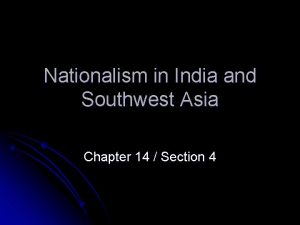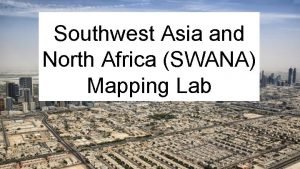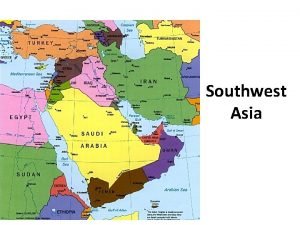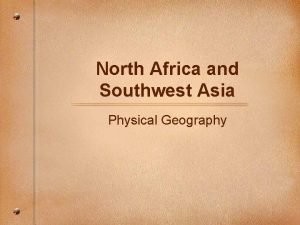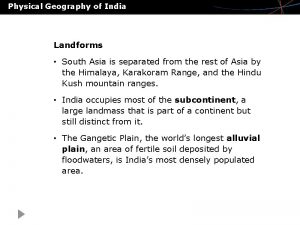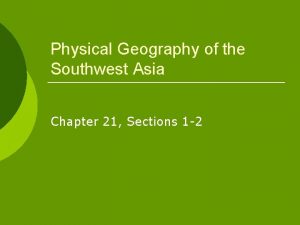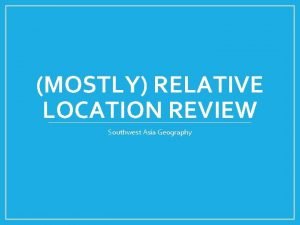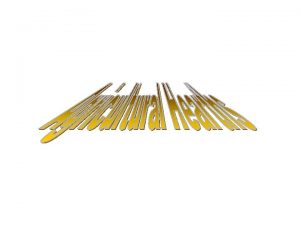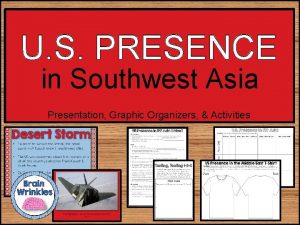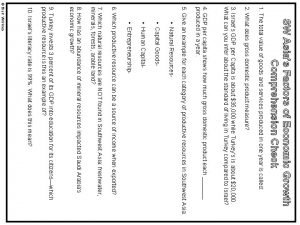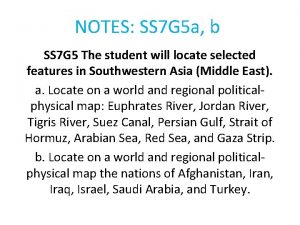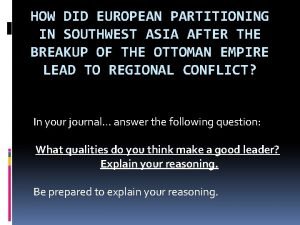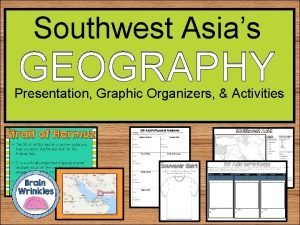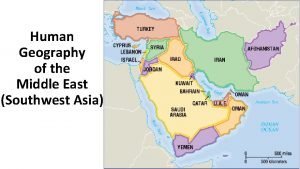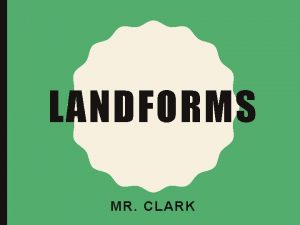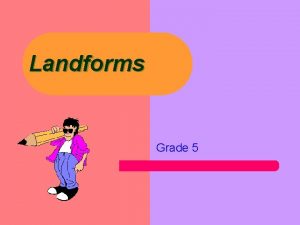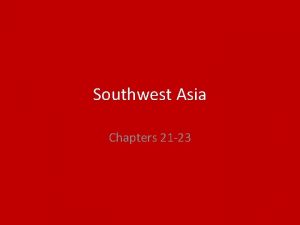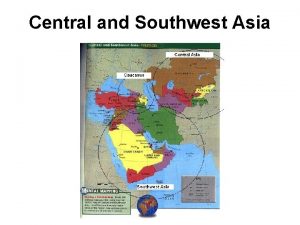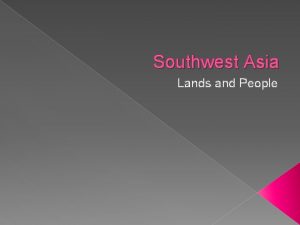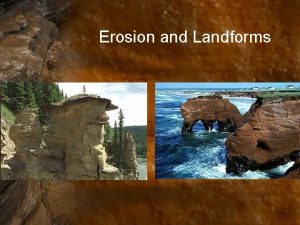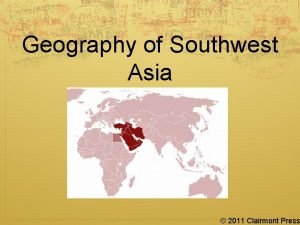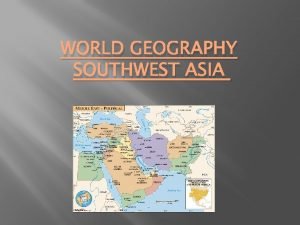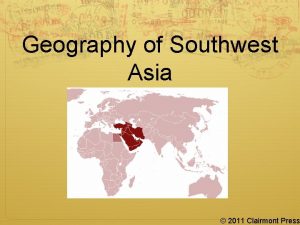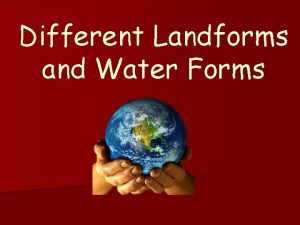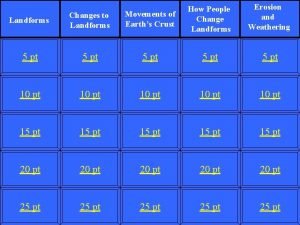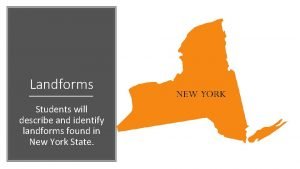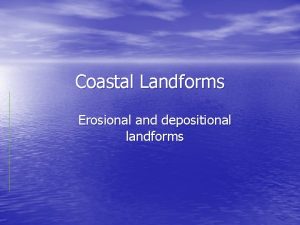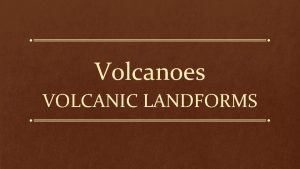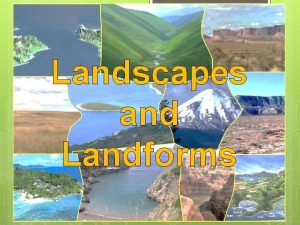Southwest Asia Landforms and Resources Southwest Asia It




































- Slides: 36

Southwest Asia: Landforms and Resources

Southwest Asia. It looks like this:

Southwest Asia encompasses the area we typically think of as the Middle-East. • The place isn’t all a big desert, so let’s look at some of the landforms.

Peninsulas • The biggest peninsula is the Arabian peninsula, which is dominated by Saudi Arabia


• The other big one is the Anatolian Peninsula, which is modern-day Turkey.


Waterways • Red Sea

• Suez Canal • Connects the Red Sea with the Mediterranean Sea, which makes it a very important waterway.



• Black Sea • Just above Turkey.


• Bosporus and Dardanelle Straits • Straits that connect the Black Sea with the Mediterranean. • Very important location since they control sea access between the two seas as well as land access from Europe to the Middle East.


Turkey’s capital city of Istanbul (it was once Constantinople) is located on the Bosporus Strait.



• Arabian Sea and the Persian Gulf • The Arabian Sea is north of the Indian Ocean and the Persian Gulf is sandwiched between Saudi Arabia and Iran.

• They’re connected by the Straits of Hormuz

• This area is very important because this is where all the Middle Eastern oil is shipped from.

• Dead Sea • We’ve looked at this one before, but one more time!

• The saltiest lake is the Dead Sea in Israel and Jordan. It has no outlet and a high evaporation rate, so the salt concentrates even more. It’s so salty (about nine times that of the ocean), it can’t support life. • Its shores are also the lowest dry point on Earth: about 1, 350 feet below sea level (you’re currently about 45 feet above sea level) • And the salinity (saltiness) allows you to float without effort. Like these guys:

That’s because the water is so much denser than you that it makes you naturally buoyant. Just don’t get the water in your eyes. It’ll sting.

• Jordan River • Important water source that also serves as the boundary between Israel and Jordan. • Flows into the Dead Sea.

• Tigris and Euphrates Rivers • Twin rivers that run through modern-day Iraq.

• The land in between the two rivers is very fertile and a lot of agriculture takes place there. • Because of this, the area is known as the fertile crescent. • Some of the earliest civilizations developed here because of its agricultural bounty.

Plains • Most of the Arabian Peninsula is dry, sandy, and flat. There’s not much there. • The wadis are dry riverbeds.

Highlands and mountains • Iranian plateau • The central area of Iran is on a plateau and surrounded by mountains. The area is laregly desert -like.


• The bulk of the Anatolian Peninsula is also a plateau

• Hejaz Mountains • On the southwestern Arabian Peninsula • Hindu Kush Mountains • In eastern Afghanistan

• Zagros Mountains • On western edge of Iran • Elburz Mountains • Taurus Mountains • Mountains

Resources • Oil. Black gold. Texas Tea. • There’s a lot of it in SW Asia… roughly half of the known oil reserves are in this region, which makes it rather important.


 Chapter 21 section 1 landforms and resources answer key
Chapter 21 section 1 landforms and resources answer key Southwest asia landforms
Southwest asia landforms How would you describe this
How would you describe this Chapter 24 the land where continents collided answer key
Chapter 24 the land where continents collided answer key Landforms and resources
Landforms and resources China population density
China population density Landforms and resources section 1
Landforms and resources section 1 Chapter 18 section 1 landforms and resources
Chapter 18 section 1 landforms and resources Natural resources in the canadian shield
Natural resources in the canadian shield Chapter 5 section 1 landforms and resources
Chapter 5 section 1 landforms and resources Chapter 4 landforms water and natural resources
Chapter 4 landforms water and natural resources South west asia and north africa map
South west asia and north africa map Political map of southwest asia and north africa
Political map of southwest asia and north africa Nationalism in india and southwest asia
Nationalism in india and southwest asia The sacred book of islam
The sacred book of islam Southwest and central asia mapping lab answer key
Southwest and central asia mapping lab answer key North africa and southwest asia physical geography
North africa and southwest asia physical geography Nationalism in india and southwest asia
Nationalism in india and southwest asia Nationalism in india and southwest asia
Nationalism in india and southwest asia Peninsulas and waterways in southwest asia
Peninsulas and waterways in southwest asia North africa southwest asia physical map
North africa southwest asia physical map North africa and southwest asia mountains
North africa and southwest asia mountains South asia landforms
South asia landforms Environmental issues graphic organizer
Environmental issues graphic organizer Chapter 21 physical geography of southwest asia
Chapter 21 physical geography of southwest asia Which southwest asian country is the farthest east
Which southwest asian country is the farthest east Chapter 22 human geography of southwest asia
Chapter 22 human geography of southwest asia Southwest asia hearth
Southwest asia hearth Brain wrinkles southwest asia answer key
Brain wrinkles southwest asia answer key Somebody wanted but so us presence in sw asia
Somebody wanted but so us presence in sw asia Sw asian economies comprehension check
Sw asian economies comprehension check Site:slidetodoc.com
Site:slidetodoc.com Tigris river map
Tigris river map Republic in southwest arabia
Republic in southwest arabia Europe partitioning in southwest asia answer key
Europe partitioning in southwest asia answer key South west asia
South west asia Human geography of the middle east
Human geography of the middle east

